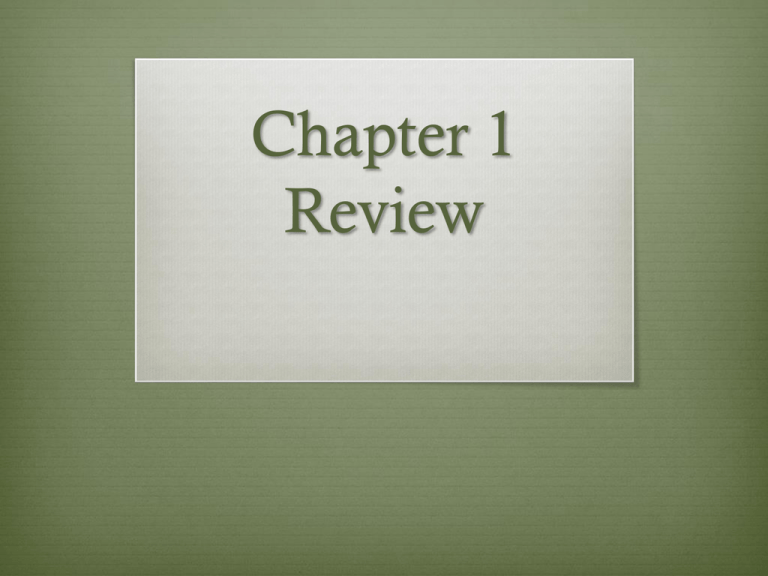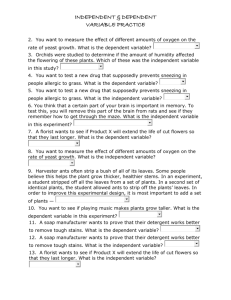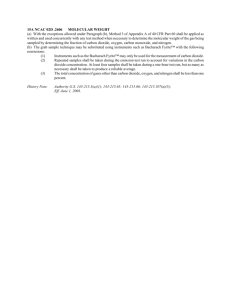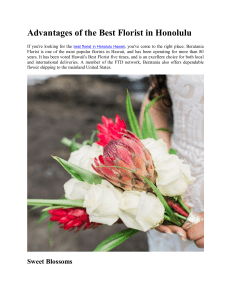Chapter 1 Review PPT
advertisement

Chapter 1 Review General terms Biology Biosphere Biodiversity (where is biodiversity the greatest on earth? Why?) Organism Species (what makes a group of organisms a species?) Cell Metabolism What are the 5 characteristics of life? Hint: Red Roosters Drive Everyone Crazy Real cats eat dead rats? Characteristics of Life Red- Reproduction Roosters- Response to environment Drive- Development Everyone- Energy Crazy- Cells Unifying Themes What are the 4 unifying themes of biology? Hint: Even Sue and Fred Study Hard Unifying Themes Even- Evolution explains unity and diversity Sue and Fred- Structure and function are related Study- Systems of related parts Hard- all organisms must maintain Homeostasis More Terms System Homeostasis Evolution Adaptation Ecosystem Chapter 1 Review Questions 1. What term describes proposed answer to a scientific question? (A) observation (B) independent variable (C) dependent variable (D) hypothesis 2. What condition in an experiment does a biologist manipulate? (A) independent variable (B) dependent variable (C) control (D) constant 3. Provide an example that displays the importance of and the difference between constants and controls. Answers 1. What term describes proposed answer to a scientific question? (A) observation (B) independent variable (C) dependent variable (D) hypothesis 2. What condition in an experiment does a biologist manipulate? (A) independent variable (B) dependent variable (C) control (D) constant 3. Provide an example that displays the importance of and the difference between constants and controls. Answers vary. Constants- conditions that do not change. Control- treated like the experimental group except for the independent variable being studied. Used for comparison. Review questions Continued 4. What is the sequence of scientific inquiry? 5. Which is an example of qualitative data? (A) There were twelve colonies left after exposure to antibiotics (B) The chemical reaction produced a product that smelled like vanilla. (C) The mass of the product formed was 147.2 grams. (D) The volume of the liquid was102 mL. Answers cont. 4.Which is the correct sequence of scientific inquiry? Don’t fixate so much on the number of steps. Understand the process involves observing, hypothesizing, experimenting, analyzing, and evaluating/concluding 5. Which is an example of qualitative data? (A) There were twelve colonies left after exposure to antibiotics (B) The chemical reaction produced a product that smelled like vanilla. (C) The mass of the product formed was 147.2 grams. (D) The volume of the liquid was102 mL. Independent vs Dependent Variables You want to measure the effect of different amounts of sugar on the amount of carbon dioxide released by yeast. What is the independent variable? A florist wants to see if Product X will extend the life of cut flowers so that they last longer. What is the independent variable? You want to test a new drug that supposedly prevents sneezing in people allergic to grass. What is the independent variable? Answers You want to measure the effect of different amounts of sugar on the amount of carbon dioxide released by yeast. What is the independent variable? amount of sugar or amount of carbon dioxide A florist wants to see if Product X will extend the life of cut flowers so that they last longer. What is the independent variable? the life of the flowers or Product X You want to test a new drug that supposedly prevents sneezing in people allergic to grass. What is the independent variable? Sneezing or drug Which are observations, which are inferences? The table tops in this classroom are black. The sky is darkening because a storm is approaching Mr. Kicklighter coughed so he is sick There are four bullets on this slide More terms Gene Genomics Biotechnology Microscope *don’t forget to review lab tools and lab safety!








